Principles of Project Management: Project Selection Methods Report
VerifiedAdded on 2022/08/29
|8
|2169
|19
Report
AI Summary
This report delves into project selection methods, focusing on the Benefit Measurement Method (BMM) as a suitable approach for SingularLogic. It explores various techniques within BMM, including Cost-Benefit Ratio, Economic Model, Payback Period, Discounted Cash Flow, Net Present Value, Scoring Models, Internal Rate of Return, and Opportunity Cost. The report outlines the processes involved in each method, providing a comprehensive understanding of their application in project evaluation. Furthermore, it examines the initiation process group, emphasizing the importance of project charter, stakeholder register, and other project documents. The report highlights the significance of these documents in defining project scope, aligning stakeholder expectations, and ensuring project success. References to relevant literature are included to support the analysis.

Running head: PRINCIPLES OF PROJECT MANAGEMENT
Principles of Project Management
Name of Student-
Name of Student-
Author’s Note-
Principles of Project Management
Name of Student-
Name of Student-
Author’s Note-
Paraphrase This Document
Need a fresh take? Get an instant paraphrase of this document with our AI Paraphraser
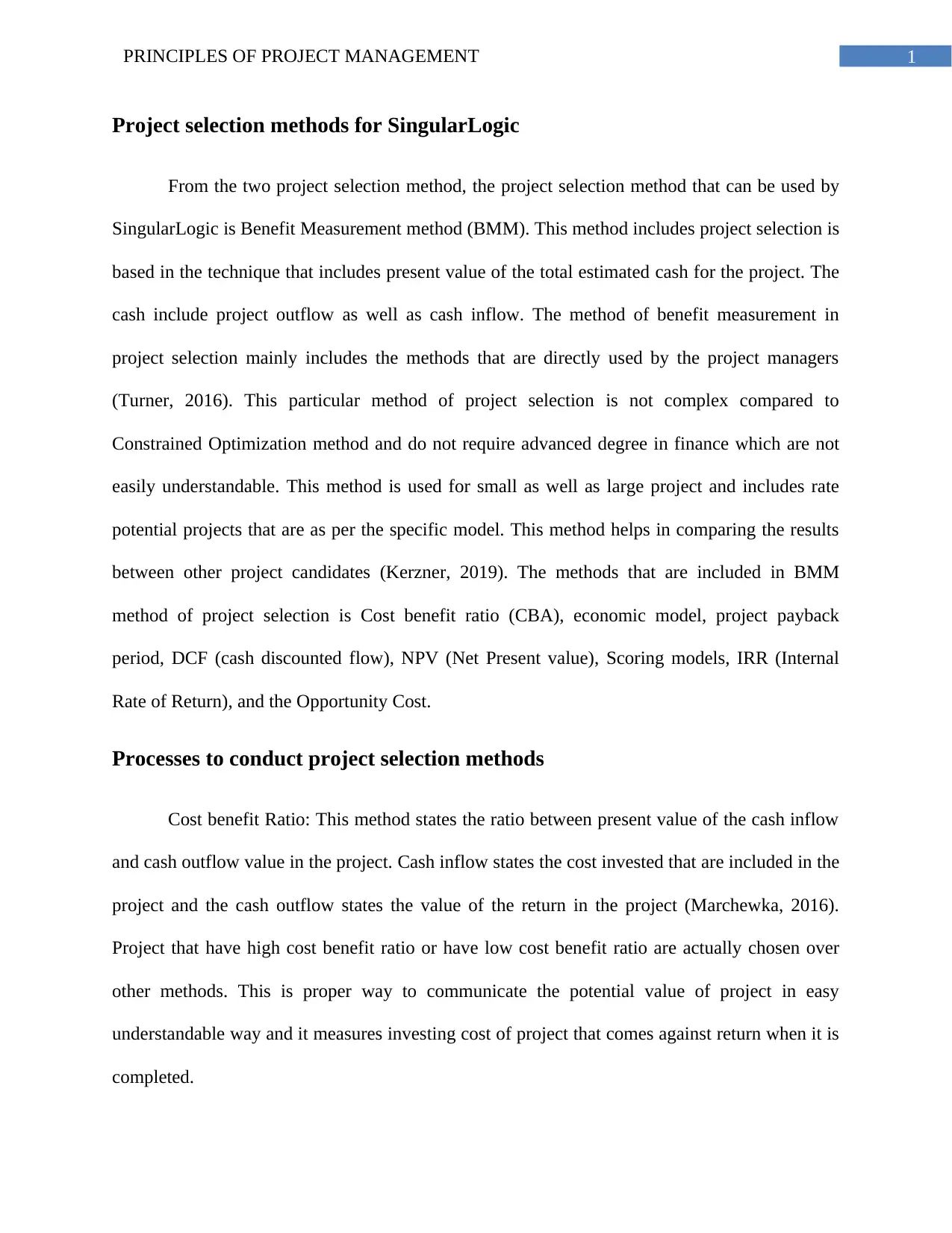
1PRINCIPLES OF PROJECT MANAGEMENT
Project selection methods for SingularLogic
From the two project selection method, the project selection method that can be used by
SingularLogic is Benefit Measurement method (BMM). This method includes project selection is
based in the technique that includes present value of the total estimated cash for the project. The
cash include project outflow as well as cash inflow. The method of benefit measurement in
project selection mainly includes the methods that are directly used by the project managers
(Turner, 2016). This particular method of project selection is not complex compared to
Constrained Optimization method and do not require advanced degree in finance which are not
easily understandable. This method is used for small as well as large project and includes rate
potential projects that are as per the specific model. This method helps in comparing the results
between other project candidates (Kerzner, 2019). The methods that are included in BMM
method of project selection is Cost benefit ratio (CBA), economic model, project payback
period, DCF (cash discounted flow), NPV (Net Present value), Scoring models, IRR (Internal
Rate of Return), and the Opportunity Cost.
Processes to conduct project selection methods
Cost benefit Ratio: This method states the ratio between present value of the cash inflow
and cash outflow value in the project. Cash inflow states the cost invested that are included in the
project and the cash outflow states the value of the return in the project (Marchewka, 2016).
Project that have high cost benefit ratio or have low cost benefit ratio are actually chosen over
other methods. This is proper way to communicate the potential value of project in easy
understandable way and it measures investing cost of project that comes against return when it is
completed.
Project selection methods for SingularLogic
From the two project selection method, the project selection method that can be used by
SingularLogic is Benefit Measurement method (BMM). This method includes project selection is
based in the technique that includes present value of the total estimated cash for the project. The
cash include project outflow as well as cash inflow. The method of benefit measurement in
project selection mainly includes the methods that are directly used by the project managers
(Turner, 2016). This particular method of project selection is not complex compared to
Constrained Optimization method and do not require advanced degree in finance which are not
easily understandable. This method is used for small as well as large project and includes rate
potential projects that are as per the specific model. This method helps in comparing the results
between other project candidates (Kerzner, 2019). The methods that are included in BMM
method of project selection is Cost benefit ratio (CBA), economic model, project payback
period, DCF (cash discounted flow), NPV (Net Present value), Scoring models, IRR (Internal
Rate of Return), and the Opportunity Cost.
Processes to conduct project selection methods
Cost benefit Ratio: This method states the ratio between present value of the cash inflow
and cash outflow value in the project. Cash inflow states the cost invested that are included in the
project and the cash outflow states the value of the return in the project (Marchewka, 2016).
Project that have high cost benefit ratio or have low cost benefit ratio are actually chosen over
other methods. This is proper way to communicate the potential value of project in easy
understandable way and it measures investing cost of project that comes against return when it is
completed.
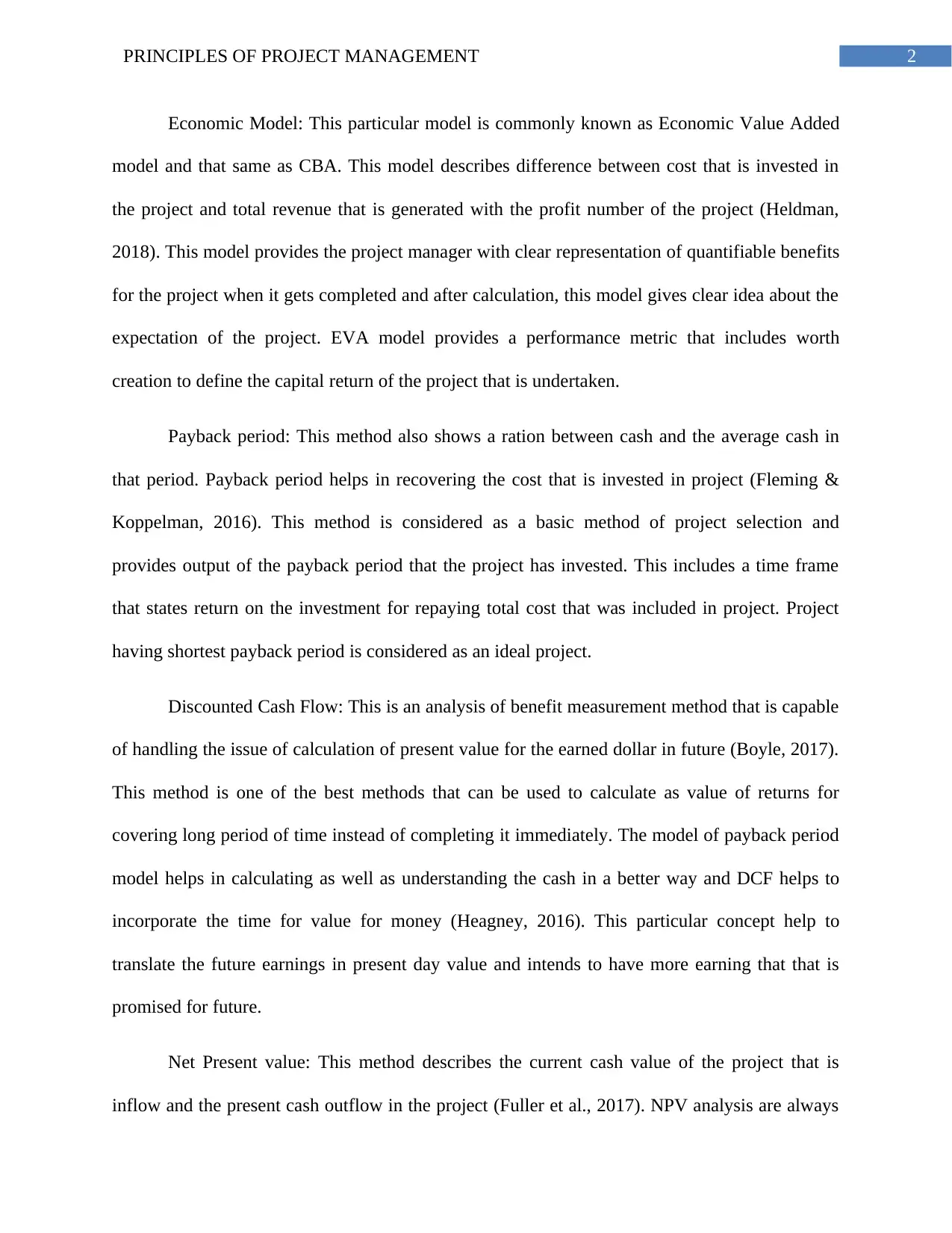
2PRINCIPLES OF PROJECT MANAGEMENT
Economic Model: This particular model is commonly known as Economic Value Added
model and that same as CBA. This model describes difference between cost that is invested in
the project and total revenue that is generated with the profit number of the project (Heldman,
2018). This model provides the project manager with clear representation of quantifiable benefits
for the project when it gets completed and after calculation, this model gives clear idea about the
expectation of the project. EVA model provides a performance metric that includes worth
creation to define the capital return of the project that is undertaken.
Payback period: This method also shows a ration between cash and the average cash in
that period. Payback period helps in recovering the cost that is invested in project (Fleming &
Koppelman, 2016). This method is considered as a basic method of project selection and
provides output of the payback period that the project has invested. This includes a time frame
that states return on the investment for repaying total cost that was included in project. Project
having shortest payback period is considered as an ideal project.
Discounted Cash Flow: This is an analysis of benefit measurement method that is capable
of handling the issue of calculation of present value for the earned dollar in future (Boyle, 2017).
This method is one of the best methods that can be used to calculate as value of returns for
covering long period of time instead of completing it immediately. The model of payback period
model helps in calculating as well as understanding the cash in a better way and DCF helps to
incorporate the time for value for money (Heagney, 2016). This particular concept help to
translate the future earnings in present day value and intends to have more earning that that is
promised for future.
Net Present value: This method describes the current cash value of the project that is
inflow and the present cash outflow in the project (Fuller et al., 2017). NPV analysis are always
Economic Model: This particular model is commonly known as Economic Value Added
model and that same as CBA. This model describes difference between cost that is invested in
the project and total revenue that is generated with the profit number of the project (Heldman,
2018). This model provides the project manager with clear representation of quantifiable benefits
for the project when it gets completed and after calculation, this model gives clear idea about the
expectation of the project. EVA model provides a performance metric that includes worth
creation to define the capital return of the project that is undertaken.
Payback period: This method also shows a ration between cash and the average cash in
that period. Payback period helps in recovering the cost that is invested in project (Fleming &
Koppelman, 2016). This method is considered as a basic method of project selection and
provides output of the payback period that the project has invested. This includes a time frame
that states return on the investment for repaying total cost that was included in project. Project
having shortest payback period is considered as an ideal project.
Discounted Cash Flow: This is an analysis of benefit measurement method that is capable
of handling the issue of calculation of present value for the earned dollar in future (Boyle, 2017).
This method is one of the best methods that can be used to calculate as value of returns for
covering long period of time instead of completing it immediately. The model of payback period
model helps in calculating as well as understanding the cash in a better way and DCF helps to
incorporate the time for value for money (Heagney, 2016). This particular concept help to
translate the future earnings in present day value and intends to have more earning that that is
promised for future.
Net Present value: This method describes the current cash value of the project that is
inflow and the present cash outflow in the project (Fuller et al., 2017). NPV analysis are always
⊘ This is a preview!⊘
Do you want full access?
Subscribe today to unlock all pages.

Trusted by 1+ million students worldwide
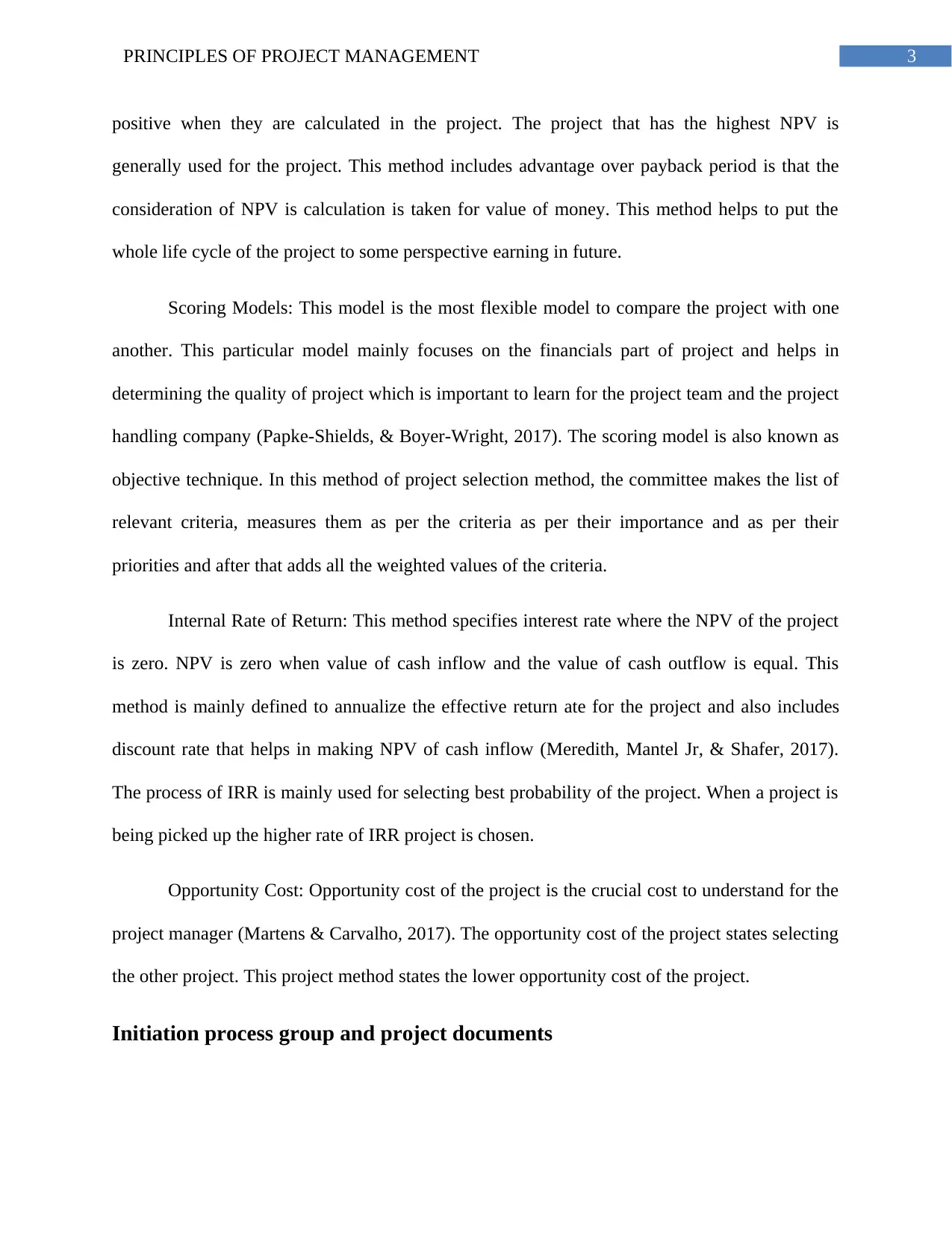
3PRINCIPLES OF PROJECT MANAGEMENT
positive when they are calculated in the project. The project that has the highest NPV is
generally used for the project. This method includes advantage over payback period is that the
consideration of NPV is calculation is taken for value of money. This method helps to put the
whole life cycle of the project to some perspective earning in future.
Scoring Models: This model is the most flexible model to compare the project with one
another. This particular model mainly focuses on the financials part of project and helps in
determining the quality of project which is important to learn for the project team and the project
handling company (Papke-Shields, & Boyer-Wright, 2017). The scoring model is also known as
objective technique. In this method of project selection method, the committee makes the list of
relevant criteria, measures them as per the criteria as per their importance and as per their
priorities and after that adds all the weighted values of the criteria.
Internal Rate of Return: This method specifies interest rate where the NPV of the project
is zero. NPV is zero when value of cash inflow and the value of cash outflow is equal. This
method is mainly defined to annualize the effective return ate for the project and also includes
discount rate that helps in making NPV of cash inflow (Meredith, Mantel Jr, & Shafer, 2017).
The process of IRR is mainly used for selecting best probability of the project. When a project is
being picked up the higher rate of IRR project is chosen.
Opportunity Cost: Opportunity cost of the project is the crucial cost to understand for the
project manager (Martens & Carvalho, 2017). The opportunity cost of the project states selecting
the other project. This project method states the lower opportunity cost of the project.
Initiation process group and project documents
positive when they are calculated in the project. The project that has the highest NPV is
generally used for the project. This method includes advantage over payback period is that the
consideration of NPV is calculation is taken for value of money. This method helps to put the
whole life cycle of the project to some perspective earning in future.
Scoring Models: This model is the most flexible model to compare the project with one
another. This particular model mainly focuses on the financials part of project and helps in
determining the quality of project which is important to learn for the project team and the project
handling company (Papke-Shields, & Boyer-Wright, 2017). The scoring model is also known as
objective technique. In this method of project selection method, the committee makes the list of
relevant criteria, measures them as per the criteria as per their importance and as per their
priorities and after that adds all the weighted values of the criteria.
Internal Rate of Return: This method specifies interest rate where the NPV of the project
is zero. NPV is zero when value of cash inflow and the value of cash outflow is equal. This
method is mainly defined to annualize the effective return ate for the project and also includes
discount rate that helps in making NPV of cash inflow (Meredith, Mantel Jr, & Shafer, 2017).
The process of IRR is mainly used for selecting best probability of the project. When a project is
being picked up the higher rate of IRR project is chosen.
Opportunity Cost: Opportunity cost of the project is the crucial cost to understand for the
project manager (Martens & Carvalho, 2017). The opportunity cost of the project states selecting
the other project. This project method states the lower opportunity cost of the project.
Initiation process group and project documents
Paraphrase This Document
Need a fresh take? Get an instant paraphrase of this document with our AI Paraphraser

4PRINCIPLES OF PROJECT MANAGEMENT
Initiation Process group: The group of initiation process includes all those processes
that are performed for defining new project or add a new phase for the existing project. This is
mainly done to obtain the authorization for staring the project or the phase of the project. With
the project initiation, there are initial scope that helps in defining as well as including initial
financial resources that are included in the project (Kerzner, 2017). There are internal
stakeholder and external stakeholders who are able to interact as well as helps to influence
outcome for the project that is identified. For each project, the project stakeholders are selected
by the project manager. Information in the initiation process is captured and is documented in
project charter and in the stakeholder register. When the project charter gets approved, then the
project under process is authorized officially (Portny, 2017). The project team in a project help to
write project charter and this helps to assume that business case assessment in the project and
helps to approve as well as fund the project boundaries. This boundary helps in defining the
point of time that helps to start or can complete the project and project phase gets authorized.
The main purpose of the process group is that it helps in aligning all the expectation of the
stakeholders with that of the project purpose. This helps to create visibility regarding the project
scope and the project objective and the way the participation of the stakeholders is associated
with the project.
Projects those are large and complex are to be separated using different phases, and
mainly in these processes, the initiation processes are actually carried out in all the subsequent
phases so that the decisions can be validated (Badewi, 2016). With the initiating process at the
starting of the project, each of the phase can be focused with business need. The success criteria
is to be verified and that might influence he stakeholders of the projects.
Initiation Process group: The group of initiation process includes all those processes
that are performed for defining new project or add a new phase for the existing project. This is
mainly done to obtain the authorization for staring the project or the phase of the project. With
the project initiation, there are initial scope that helps in defining as well as including initial
financial resources that are included in the project (Kerzner, 2017). There are internal
stakeholder and external stakeholders who are able to interact as well as helps to influence
outcome for the project that is identified. For each project, the project stakeholders are selected
by the project manager. Information in the initiation process is captured and is documented in
project charter and in the stakeholder register. When the project charter gets approved, then the
project under process is authorized officially (Portny, 2017). The project team in a project help to
write project charter and this helps to assume that business case assessment in the project and
helps to approve as well as fund the project boundaries. This boundary helps in defining the
point of time that helps to start or can complete the project and project phase gets authorized.
The main purpose of the process group is that it helps in aligning all the expectation of the
stakeholders with that of the project purpose. This helps to create visibility regarding the project
scope and the project objective and the way the participation of the stakeholders is associated
with the project.
Projects those are large and complex are to be separated using different phases, and
mainly in these processes, the initiation processes are actually carried out in all the subsequent
phases so that the decisions can be validated (Badewi, 2016). With the initiating process at the
starting of the project, each of the phase can be focused with business need. The success criteria
is to be verified and that might influence he stakeholders of the projects.
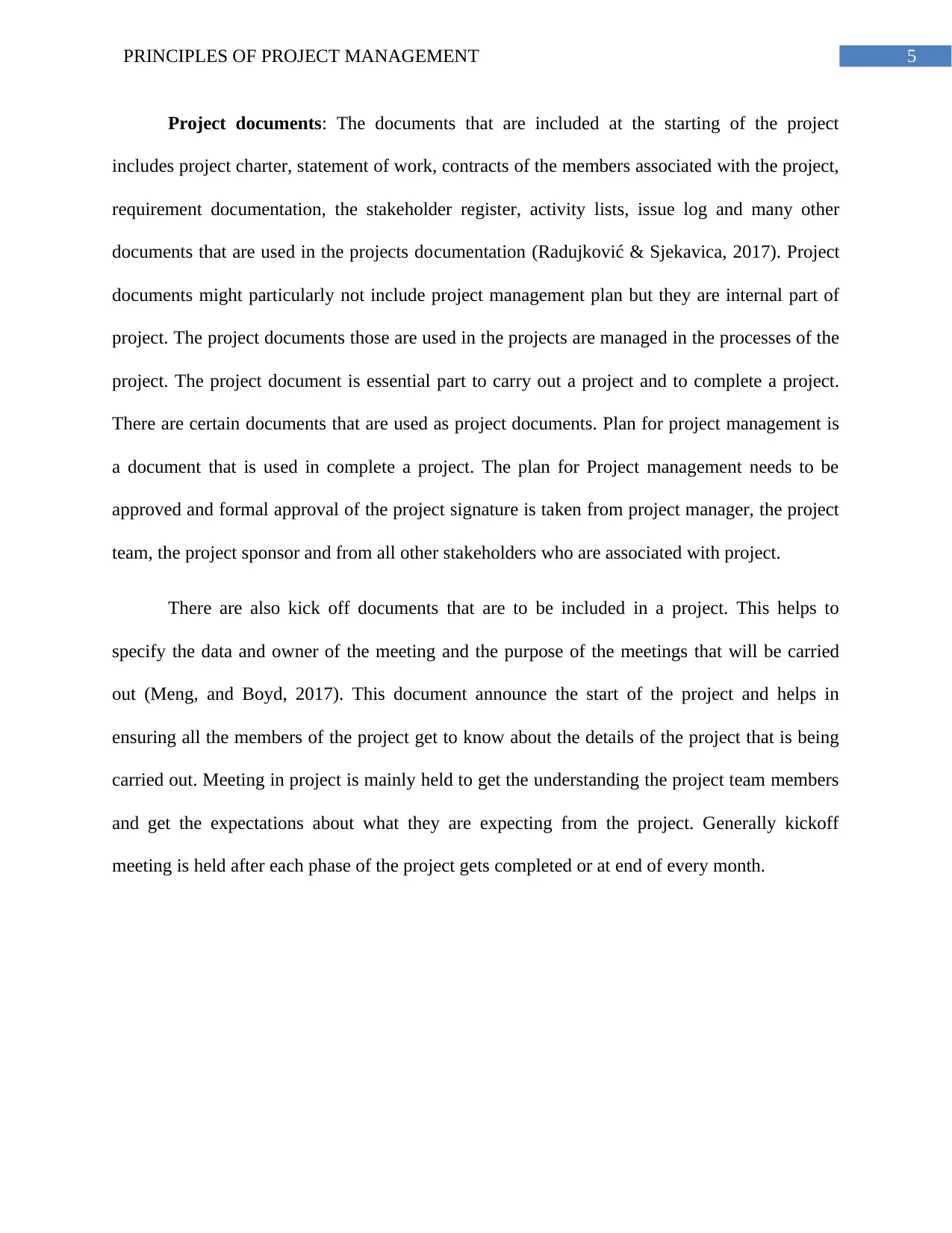
5PRINCIPLES OF PROJECT MANAGEMENT
Project documents: The documents that are included at the starting of the project
includes project charter, statement of work, contracts of the members associated with the project,
requirement documentation, the stakeholder register, activity lists, issue log and many other
documents that are used in the projects documentation (Radujković & Sjekavica, 2017). Project
documents might particularly not include project management plan but they are internal part of
project. The project documents those are used in the projects are managed in the processes of the
project. The project document is essential part to carry out a project and to complete a project.
There are certain documents that are used as project documents. Plan for project management is
a document that is used in complete a project. The plan for Project management needs to be
approved and formal approval of the project signature is taken from project manager, the project
team, the project sponsor and from all other stakeholders who are associated with project.
There are also kick off documents that are to be included in a project. This helps to
specify the data and owner of the meeting and the purpose of the meetings that will be carried
out (Meng, and Boyd, 2017). This document announce the start of the project and helps in
ensuring all the members of the project get to know about the details of the project that is being
carried out. Meeting in project is mainly held to get the understanding the project team members
and get the expectations about what they are expecting from the project. Generally kickoff
meeting is held after each phase of the project gets completed or at end of every month.
Project documents: The documents that are included at the starting of the project
includes project charter, statement of work, contracts of the members associated with the project,
requirement documentation, the stakeholder register, activity lists, issue log and many other
documents that are used in the projects documentation (Radujković & Sjekavica, 2017). Project
documents might particularly not include project management plan but they are internal part of
project. The project documents those are used in the projects are managed in the processes of the
project. The project document is essential part to carry out a project and to complete a project.
There are certain documents that are used as project documents. Plan for project management is
a document that is used in complete a project. The plan for Project management needs to be
approved and formal approval of the project signature is taken from project manager, the project
team, the project sponsor and from all other stakeholders who are associated with project.
There are also kick off documents that are to be included in a project. This helps to
specify the data and owner of the meeting and the purpose of the meetings that will be carried
out (Meng, and Boyd, 2017). This document announce the start of the project and helps in
ensuring all the members of the project get to know about the details of the project that is being
carried out. Meeting in project is mainly held to get the understanding the project team members
and get the expectations about what they are expecting from the project. Generally kickoff
meeting is held after each phase of the project gets completed or at end of every month.
⊘ This is a preview!⊘
Do you want full access?
Subscribe today to unlock all pages.

Trusted by 1+ million students worldwide

6PRINCIPLES OF PROJECT MANAGEMENT
References
Badewi, A. (2016). The impact of project management (PM) and benefits management (BM)
practices on project success: Towards developing a project benefits governance
framework. International Journal of Project Management, 34(4), 761-778.
Boyle, G. (2017). Design project management. Routledge.
Fleming, Q. W., & Koppelman, J. M. (2016, December). Earned value project management.
Project Management Institute.
Fuller, M. A., Valacich, J. S., George, J. F., & Schneider, C. (2017). Information Systems Project
Management: A Process and Team Approach, Edition 1.1. Prospect Press.
Heagney, J. (2016). Fundamentals of project management. Amacom.
Heldman, K. (2018). PMP: project management professional exam study guide. John Wiley &
Sons.
Kerzner, H. (2017). Project management: a systems approach to planning, scheduling, and
controlling. John Wiley & Sons.
Kerzner, H. (2019). Using the project management maturity model: strategic planning for
project management. John Wiley & Sons.
Marchewka, J. T. (2016). Information technology project management: Providing measurable
organizational value. John Wiley & Sons.
References
Badewi, A. (2016). The impact of project management (PM) and benefits management (BM)
practices on project success: Towards developing a project benefits governance
framework. International Journal of Project Management, 34(4), 761-778.
Boyle, G. (2017). Design project management. Routledge.
Fleming, Q. W., & Koppelman, J. M. (2016, December). Earned value project management.
Project Management Institute.
Fuller, M. A., Valacich, J. S., George, J. F., & Schneider, C. (2017). Information Systems Project
Management: A Process and Team Approach, Edition 1.1. Prospect Press.
Heagney, J. (2016). Fundamentals of project management. Amacom.
Heldman, K. (2018). PMP: project management professional exam study guide. John Wiley &
Sons.
Kerzner, H. (2017). Project management: a systems approach to planning, scheduling, and
controlling. John Wiley & Sons.
Kerzner, H. (2019). Using the project management maturity model: strategic planning for
project management. John Wiley & Sons.
Marchewka, J. T. (2016). Information technology project management: Providing measurable
organizational value. John Wiley & Sons.
Paraphrase This Document
Need a fresh take? Get an instant paraphrase of this document with our AI Paraphraser
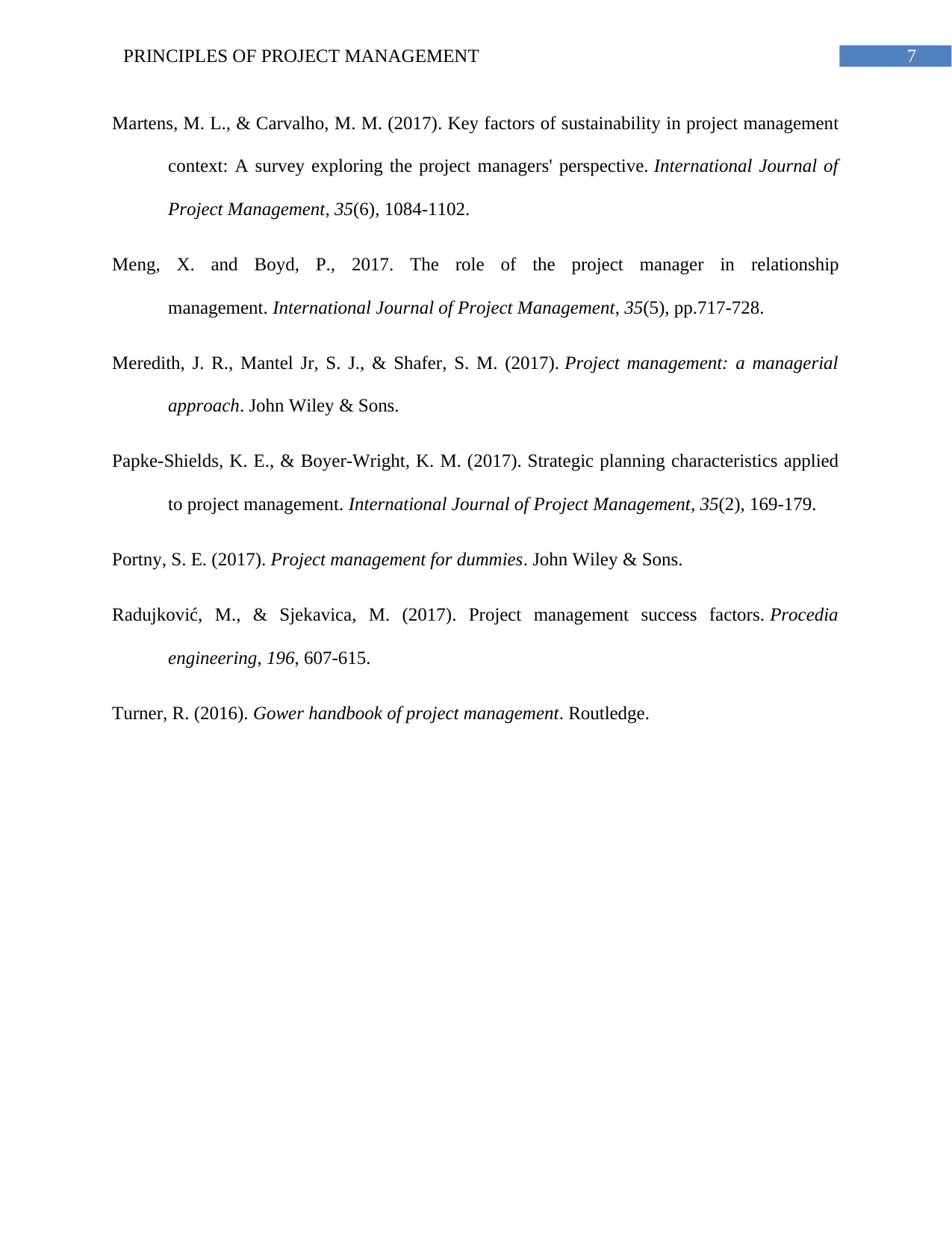
7PRINCIPLES OF PROJECT MANAGEMENT
Martens, M. L., & Carvalho, M. M. (2017). Key factors of sustainability in project management
context: A survey exploring the project managers' perspective. International Journal of
Project Management, 35(6), 1084-1102.
Meng, X. and Boyd, P., 2017. The role of the project manager in relationship
management. International Journal of Project Management, 35(5), pp.717-728.
Meredith, J. R., Mantel Jr, S. J., & Shafer, S. M. (2017). Project management: a managerial
approach. John Wiley & Sons.
Papke-Shields, K. E., & Boyer-Wright, K. M. (2017). Strategic planning characteristics applied
to project management. International Journal of Project Management, 35(2), 169-179.
Portny, S. E. (2017). Project management for dummies. John Wiley & Sons.
Radujković, M., & Sjekavica, M. (2017). Project management success factors. Procedia
engineering, 196, 607-615.
Turner, R. (2016). Gower handbook of project management. Routledge.
Martens, M. L., & Carvalho, M. M. (2017). Key factors of sustainability in project management
context: A survey exploring the project managers' perspective. International Journal of
Project Management, 35(6), 1084-1102.
Meng, X. and Boyd, P., 2017. The role of the project manager in relationship
management. International Journal of Project Management, 35(5), pp.717-728.
Meredith, J. R., Mantel Jr, S. J., & Shafer, S. M. (2017). Project management: a managerial
approach. John Wiley & Sons.
Papke-Shields, K. E., & Boyer-Wright, K. M. (2017). Strategic planning characteristics applied
to project management. International Journal of Project Management, 35(2), 169-179.
Portny, S. E. (2017). Project management for dummies. John Wiley & Sons.
Radujković, M., & Sjekavica, M. (2017). Project management success factors. Procedia
engineering, 196, 607-615.
Turner, R. (2016). Gower handbook of project management. Routledge.
1 out of 8
Related Documents
Your All-in-One AI-Powered Toolkit for Academic Success.
+13062052269
info@desklib.com
Available 24*7 on WhatsApp / Email
![[object Object]](/_next/static/media/star-bottom.7253800d.svg)
Unlock your academic potential
Copyright © 2020–2025 A2Z Services. All Rights Reserved. Developed and managed by ZUCOL.





